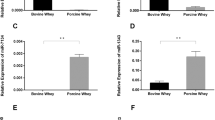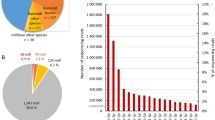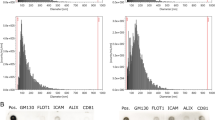Abstract
Background/Objectives:
Specific microRNAs (miRNAs) that are known to have roles in various physiological and pathological processes in mammals are found in human breast milk, but the impact of maternal status on miRNA levels in milk is not fully understood. The objective of this study was to explore maternal and infant factors that can potentially influence the levels of let-7a (MIMAT0000062), miRNA-30B (MIMAT0000420) and miRNA-378 (MIMAT0000732) in human milk, all of which are known to participate in adipogenesis.
Subjects/Methods:
Colostrum from 86 mothers and mature milk from 33 mothers were collected. The miRNA levels in these samples were determined using real-time PCR. Correlations between the levels of these miRNAs and lactation duration, maternal weight/BMI before and late in the pregnancy, maternal age, gestational weeks and infant gender were analysed.
Results:
The levels of let-7a (2.58±0.67) and miRNA-378 (4.64±0.69) in colostrum were higher than those in mature milk (2.39±0.62, 3.62±0.77, P<0.01). Conversely, the level of miRNA-30B was higher in mature milk (4.92±0.57) than in colostrum (4.05±0.61, P<0.01). The levels of miRNA-30B, let-7a and miRNA-378 in colostrum were negatively correlated with maternal pre-pregnancy BMI (P<0.01), and, in mature milk, let-7a was negatively correlated with maternal weight late in the pregnancy (P<0.05). Moreover, miRNA-30B and miRNA-378 were higher in the colostrum received by girls than in that received by boys (P<0.01). This pattern held for miRNA-378 when controlling for maternal pre-pregnancy BMI.
Conclusions:
Adipogenesis miRNAs were expressed in both colostrum and mature milk and were related to maternal weight and infant gender. The miRNAs in human milk determined in this study provide a basis for future studies of their biological functions in infants.
This is a preview of subscription content, access via your institution
Access options
Subscribe to this journal
Receive 12 print issues and online access
$259.00 per year
only $21.58 per issue
Buy this article
- Purchase on Springer Link
- Instant access to full article PDF
Prices may be subject to local taxes which are calculated during checkout


Similar content being viewed by others
References
Gillman MW, Rifas-Shiman SL, Camargo CJ, Berkey CS, Frazier AL, Rockett HR et al. Risk of overweight among adolescents who were breastfed as infants. JAMA 2001; 285: 2461–2467.
Catli G, Olgac DN, Dundar BN . Adipokines in breast milk: an update. J Clin Res Pediatr Endocrinol 2014; 6: 192–201.
Karatas Z, Durmus AS, Dinleyici EC, Colak O, Dogruel N . Breastmilk ghrelin, leptin, and fat levels changing foremilk to hindmilk: is that important for self-control of feeding? Eur J Pediatr 2011; 170: 1273–1280.
Ambros V . The functions of animal microRNAs. Nature 2004; 431: 350–355.
Krutzfeldt J, Stoffel M . MicroRNAs: a new class of regulatory genes affecting metabolism. Cell Metab 2006; 4: 9–12.
Chen X, Ba Y, Ma L, Cai X, Yin Y, Wang K et al. Characterization of microRNAs in serum: a novel class of biomarkers for diagnosis of cancer and other diseases. Cell Res 2008; 18: 997–1006.
Weber JA, Baxter DH, Zhang S, Huang DY, Huang KH, Lee MJ et al. The microRNA spectrum in 12 body fluids. Clin Chem 2010; 56: 1733–1741.
Kosaka N, Izumi H, Sekine K, Ochiya T . microRNA as a new immune-regulatory agent in breast milk. Silence 2010; 1: 7.
Izumi H, Kosaka N, Shimizu T, Sekine K, Ochiya T, Takase M . Bovine milk contains microRNA and messenger RNA that are stable under degradative conditions. J Dairy Sci 2012; 95: 4831–4841.
Zhang L, Hou D, Chen X, Li D, Zhu L, Zhang Y et al. Exogenous plant MIR168a specifically targets mammalian LDLRAP1: evidence of cross-kingdom regulation by microRNA. Cell Res 2012; 22: 107–126.
Lasser C, Alikhani VS, Ekstrom K, Eldh M, Paredes PT, Bossios A et al. Human saliva, plasma and breast milk exosomes contain RNA: uptake by macrophages. J Transl Med 2011; 9: 9.
Zhou Q, Li M, Wang X, Li Q, Wang T, Zhu Q et al. Immune-related microRNAs are abundant in breast milk exosomes. Int J Biol Sci 2012; 8: 118–123.
Zaragosi LE, Wdziekonski B, Brigand KL, Villageois P, Mari B, Waldmann R et al. Small RNA sequencing reveals miR-642a-3p as a novel adipocyte-specific microRNA and miR-30 as a key regulator of human adipogenesis. Genome Biol 2011; 12: R64.
Gerin I, Bommer GT, McCoin CS, Sousa KM, Krishnan V, MacDougald OA . Roles for miRNA-378/378* in adipocyte gene expression and lipogenesis. Am J Physiol Endocrinol Metab 2010; 299: E198–E206.
Sun T, Fu M, Bookout AL, Kliewer SA, Mangelsdorf DJ . MicroRNA let-7 regulates 3T3-L1 adipogenesis. Mol Endocrinol 2009; 23: 925–931.
Ling HY, Ou HS, Feng SD, Zhang XY, Tuo QH, Chen LX et al. CHANGES IN microRNA (miR) profile and effects of miR-320 in insulin-resistant 3T3-L1 adipocytes. Clin Exp Pharmacol Physiol 2009; 36: e32–e39.
Herrera BM, Lockstone HE, Taylor JM, Ria M, Barrett A, Collins S et al. Global microRNA expression profiles in insulin target tissues in a spontaneous rat model of type 2 diabetes. Diabetologia 2010; 53: 1099–1109.
He A, Zhu L, Gupta N, Chang Y, Fang F . Overexpression of micro ribonucleic acid 29, highly up-regulated in diabetic rats, leads to insulin resistance in 3T3-L1 adipocytes. Mol Endocrinol 2007; 21: 2785–2794.
Xie H, Lim B, Lodish HF . MicroRNAs induced during adipogenesis that accelerate fat cell development are downregulated in obesity. Diabetes 2009; 58: 1050–1057.
Martin LJ, Woo JG, Geraghty SR, Altaye M, Davidson BS, Banach W et al. Adiponectin is present in human milk and is associated with maternal factors. Am J Clin Nutr 2006; 83: 1106–1111.
Miralles O, Sanchez J, Palou A, Pico C . A physiological role of breast milk leptin in body weight control in developing infants. Obesity (Silver Spring) 2006; 14: 1371–1377.
Mehta R, Petrova A . Biologically active breast milk proteins in association with very preterm delivery and stage of lactation. J Perinatol 2011; 31: 58–62.
Ilcol YO, Hizli ZB, Ozkan T . Leptin concentration in breast milk and its relationship to duration of lactation and hormonal status. Int Breastfeed J 2006; 1: 21.
Powe CE, Knott CD, Conklin-Brittain N . Infant sex predicts breast milk energy content. Am J Hum Biol 2010; 22: 50–54.
Petherick A . Development: mother's milk: a rich opportunity. Nature 2010; 468: S5–S7.
Mandel D, Lubetzky R, Dollberg S, Barak S, Mimouni FB . Fat and energy contents of expressed human breast milk in prolonged lactation. Pediatrics 2005; 116: e432–e435.
Dallas DC, Smink CJ, Robinson RC, Tian T, Guerrero A, Parker EA et al. Endogenous human milk peptide release is greater after preterm birth than term birth. J Nutr 2015; 145: 425–433.
Baier SR, Nguyen C, Xie F, Wood JR, Zempleni J . MicroRNAs are absorbed in biologically meaningful amounts from nutritionally relevant doses of cow milk and affect gene expression in peripheral blood mononuclear cells, HEK-293 kidney cell cultures, and mouse livers. J Nutr 2014; 144: 1495–1500.
Petersen PS, Lei X, Seldin MM, Rodriguez S, Byerly MS, Wolfe A et al. Dynamic and extensive metabolic state-dependent regulation of cytokine expression and circulating levels. Am J Physiol Regul Integr Comp Physiol 2014; 307: R1458–R1470.
Ambeba EJ, Styn MA, Kuller LH, Brooks MM, Evans RW, Burke LE . Longitudinal effects of weight loss and regain on cytokine concentration of obese adults. Metabolism 2013; 62: 1218–1222.
Andreas NJ, Hyde MJ, Gale C, Parkinson JR, Jeffries S, Holmes E et al. Effect of maternal body mass index on hormones in breast milk: a systematic review. PLoS One 2014; 9: e115043.
Yan X, Huang Y, Zhao JX, Rogers CJ, Zhu MJ, Ford SP et al. Maternal obesity downregulates microRNA let-7 g expression, a possible mechanism for enhanced adipogenesis during ovine fetal skeletal muscle development. Int J Obes (Lond) 2013; 37: 568–575.
Noureldeen AF, Qusti SY, Al-Seeni MN, Bagais MH . Maternal leptin, adiponectin, resistin, visfatin and tumor necrosis factor-alpha in normal and gestational diabetes. Indian J Clin Biochem 2014; 29: 462–470.
Zhao C, Dong J, Jiang T, Shi Z, Yu B, Zhu Y et al. Early second-trimester serum miRNA profiling predicts gestational diabetes mellitus. PLoS One 2011; 6: e23925.
Ley SH, Hanley AJ, Sermer M, Zinman B, O'Connor DL . Associations of prenatal metabolic abnormalities with insulin and adiponectin concentrations in human milk. Am J Clin Nutr 2012; 95: 867–874.
Acknowledgements
This work was supported by grants from the National Basic Research Program of China (973 Program) (2013CB530604) and the Jiangsu Province Maternal and Children Health Care Research Project (F201322). We acknowledge the contributions of the doctors and nurses of the Nanjing Drum Tower Hospital and the participation of the mothers and their babies.
Author contributions
XL and RL conceived and designed the study. YYX and XJ performed the research. YYX and MYC analysed the data. YYX wrote the manuscript. All authors read and approved the final manuscript.
Author information
Authors and Affiliations
Corresponding author
Ethics declarations
Competing interests
The authors declare no conflict of interest.
Rights and permissions
About this article
Cite this article
Xi, Y., Jiang, X., Li, R. et al. The levels of human milk microRNAs and their association with maternal weight characteristics. Eur J Clin Nutr 70, 445–449 (2016). https://doi.org/10.1038/ejcn.2015.168
Received:
Revised:
Accepted:
Published:
Issue Date:
DOI: https://doi.org/10.1038/ejcn.2015.168
This article is cited by
-
Regulation of adipogenesis by exosomal milk miRNA
Reviews in Endocrine and Metabolic Disorders (2023)
-
Periconceptional and Prenatal Exposure to Metals and Extracellular Vesicle and Particle miRNAs in Human Milk: A Pilot Study
Exposure and Health (2023)
-
Human milk extracellular vesicle miRNA expression and associations with maternal characteristics in a population-based cohort from the Faroe Islands
Scientific Reports (2021)
-
Characterization of Holstein and Normande whole milk miRNomes highlights breed specificities
Scientific Reports (2019)
-
MicroRNAs and their role in environmental chemical carcinogenesis
Environmental Geochemistry and Health (2019)



